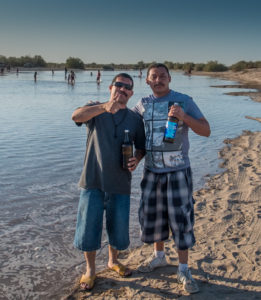
The Colorado River arrives at San Luis, March 25, 2014
“The network”, as I call the Colorado River governance structure in my book, is gathering this week in Santa Fe, New Mexico, to among other things celebrate the signing of a new agreement extending the agreement between the United States and Mexico over water sharing and allocation on the Colorado River.
Two years ago at this time, I was nervous as hell, putting the final touches on a book that argued for the fragile durability (if such an oxymoronic thing makes sense) of the framework of agreements that have held the Colorado River Basin governance process together, prevented it from spinning apart in conflict and litigation:
The events of the last two decades—the 2001 negotiations to wean California of its dependence on surplus water, the 2007 deal to share shortages, the US-Mexico agreement embodied in Minute 319—provide an indication of what the path forward might look like. They do not suggest that the Law of the River’s imperfections and ambiguities are irrelevant. Instead, they suggest that “the network” has come to the shared conclusion that arguing over legal interpretation is the wrong path. Those ambiguities and imperfections are flaws to be corrected through collective action and agreement rather than winner-take-all legal battles.
What we need is a negotiated solution that avoids narrow interpretations of the Law of the River, that reduces allocations broadly, enables trading among water users, and capitalizes on the reality that, as we have seen, communities in the Colorado River Basin have a remarkable ability to preserve their ways of life when supplies run short.
There’s something not quite right about that last paragraph, which I probably dimly realized even at the time I wrote it in 2015, but which I clearly realize now – “a negotiated solution”. In fact, what we’ll inevitably have on this river, I now realize, is a state of permanent negotiation. We can see the specific deals underway now or needed:
- the new Minute 323 agreement between the US and Mexico (with its sheaf of side agreements among the many water agencies involved)
- The ill-named “Drought Contingency Plan”, an agreement for water users on both sides of the border to take deeper cuts as Lake Mead drops
- The sub-agreements needed to make DCP work, including arrangements to do “demand management” in the Upper Basin; the necessary California side deal on the Salton Sea; Arizona’s attempt to sort out its internal politics regarding how the burden of deeper cuts is borne, and who will drive that process
- renegotiation of the 2007 Interim Guidelines, which expire in 2026
We seem to have “1” down, unless something blows up between this morning and the various US-Mexico signing ceremonies over the next couple of days. “2”, a DCP, seems close (though it seemed close back in 2015, when I was nervously wrapping up my book’s manuscript and wondering whether they’d actually do the deal in the time between the manuscript’s submission and publication, or whether the thing would fall apart in that interval). “3”, the deals needed to make a DCP work, still seems hard, which is where the risks lie for “2”.
The last, renegotiating the 2007 Interim Guidelines, is in a sense already underway. In fact, I’d argue that it’s been going on all along, ever since the Interim Guidelines were signed 10 years ago. This, I think, is the central feature of the new shape of Colorado River water governance.
This is the critical piece – a view that all these are really manifestations of the same thing, an underlying, ongoing process of river governance that includes, in part, a process of continuing negotiations. It includes constant evaluation and reevaluation of problems, constant jockeying around possible solutions, which are then slotted into the various decision processes as appropriate.
I’m moderating a panel at the Santa Fe meeting with the provocative title, “Are we up to the challenges?” This is the stuff we’ll talk about.
